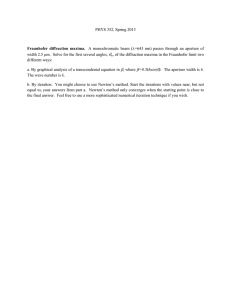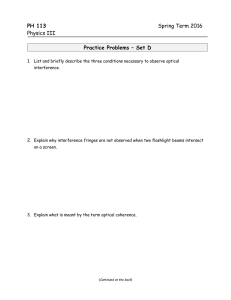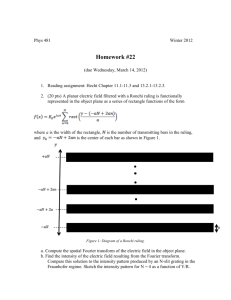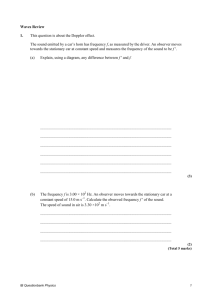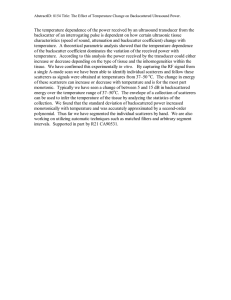Response to the "comments on ... quasilattices"
advertisement
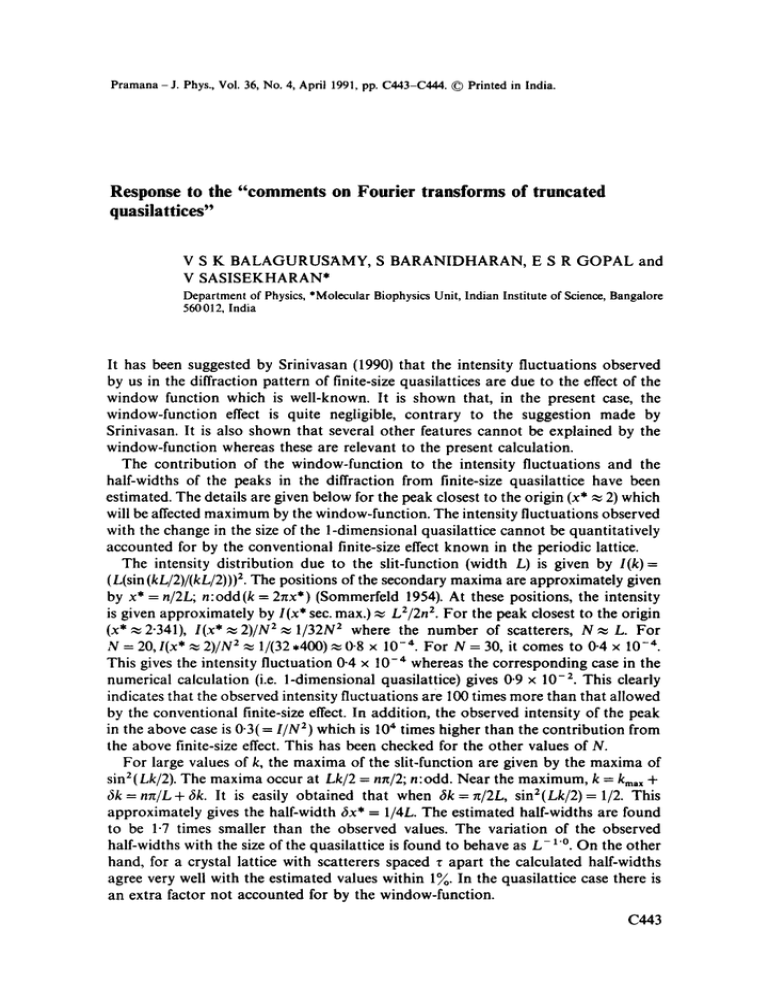
Pramana - J. Phys., Vol. 36, No. 4, April 1991, pp. C443-C444. © Printed in India. Response to the "comments on Fourier transforms of truncated quasilattices" V S K BALAGURUSAMY, S BARANIDHARAN, E S R G O P A L and V SASISEKHARAN* Department of Physics, *Molecular BiophysicsUnit, Indian Institute of Science,Bangalore 560012, India It has been suggested by Srinivasan (1990) that the intensity fluctuations observed by us in the diffraction pattern of finite-size quasilattices are due to the effect of the window function which is well-known. It is shown that, in the present case, the window-function effect is quite negligible, contrary to the suggestion made by Srinivasan. It is also shown that several other features cannot be explained by the window-function whereas these are relevant to the present calculation. The contribution of the window-funGtion to the intensity fluctuations and the half-widths of the peaks in the diffraction from finite-size quasilattice have been estimated. The details are given below for the peak closest to the origin (x* ~ 2) which will be affected maximum by the window-function. The intensity fluctuations observed with the change in the size of the l-dimensional quasilattice cannot be quantitatively accounted for by the conventional finite-size effect known in the periodic lattice. The intensity distribution due to the slit-function (width L) is given by l(k)= (L(sin (kL/2)/(kL/2))) 2. The positions of the secondary maxima are approximately given by x * = n/2L; n:odd(k = 2nx*) (Sommerfeld 1954). At these positions, the intensity is given approximately by l(x* sec. max.) ~ LZ/2n 2. For the peak closest to the origin (x* .,~ 2"341), l(x* ,~, 2)/N 2 ~ 1/32N 2 where the number of scatterers, N ,~. L. For N = 20, l(x* .~ 2)/N 2 ~ 1/(32,400) ~ 0-8 x 10 -4. For N = 30, it comes to 0-4 x 10 -4. This gives the intensity fluctuation 0-4 x 10 -4 whereas the corresponding case in the numerical calculation (i.e. 1-dimensional quasilattice) gives 0.9 x 10-2. This clearly indicates that the observed intensity fluctuations are 100 times more than that allowed by the conventional finite-size effect. In addition, the observed intensity of the peak in the above case is 0.3(= UN 2) which is 104 times higher than the contribution from the above finite-size effect. This has been checked for the other values of N. For large values of k, the maxima of the slit-function are given by the maxima of sin2(Lk/2). The maxima occur at Lk/2 = nn/2; n:odd. Near the maximum, k = km,x + 6 k = n n / L + f k . It is easily obtained that when 6k=n/2L, sin2(Lk/2)= 1/2. This approximately gives the half-width fix* = 1/4L. The estimated half-widths are found to be 1.7 times smaller than the observed values. The variation of the observed half-widths with the size of the quasilattice is found to behave as L - 1.o. On the other hand, for a crystal lattice with scatterers spaced ~ apart the calculated half-widths agree very well with the estimated values within 1%. In the quasilattice case there is an extra factor not accounted for by the window-function. C443 C444 V S K Balaourusamy et al The diffraction pattern has been already calculated from different finite segments of q uasilattice having the same width and number of scatterers (figure 12, Balagurusamy et al 1990). The peak-positions have been numerically calculated starting from the positions where the peaks would occur in the diffraction from an ideal quasilattice with the smallest interval possible (10 -6 ) and then locating the maxima nearest to them. Although the width is the same, the peak-positions have been found to shift which cannot be explained by the slit-function. This clearly indicates that the arrangement of scatterers plays a crucial role in determining the diffraction pattern. In the 2-dimensional case, though the real-space tiling (e.g. figure 6 in Baranidharan et al 1990) shown is not circular, it has been pointed out in the paper (p. 543) that only scatterers lying in the circular region were used in the Fourier transform calculations. References Balagurusamy V S K, Baranidharan S, Gopal E S R and Sasisekharan V 1990 Pramana - J. Phys. 34 525 Baranidharan S, Gopal E S R and Sasisekharan V 1990 Pramana - J. Phys. 34 537 Sommerfeld A 1954 Optics (New York: Academic Press) Srinivasan R 1991 Comments on Fourier transforms of truncated quasilattices. P r a m a n a - J . Phys. (this issue)
